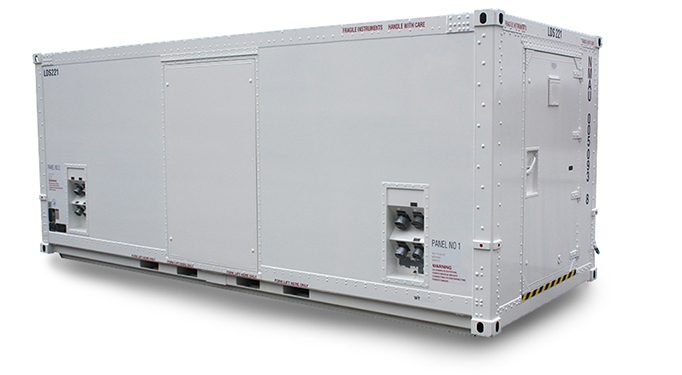
Part Number (Tactical): 206629
Part Number (Commercial) 206589
The ISO shelter is easily adapted to the diverse needs of military forces. It provides the stable indoor environment that is essential to the success of many military functions and is readily transported to any location.
By adding environmental controls, sophisticated electronic systems can be deployed worldwide. What's more, military personnel can rapidly deploy such tactical equipment to any combat theater for indefinite operation from an expeditionary base.
ISO/ANSI standardization ensures fast transport by land, sea or air.
These ISO shelters are designed to accommodate the tactical shelter requirements of the U.S. Armed Forces.
These shelters comply with applicable ISO/ANSI dimensional and structural requirements that standardize shelter dimensions, structural ratings, specifications, testing, corner fittings, markings, and terminology. This standardization facilitates air, sea, land, and rail transportation of shelters by carriers, shippers, and leasing companies.
The corner posts of these ISO shelters can withstand the weight of five loaded, stacked shelters. These units are designed to resist restraint and racking stresses caused by the side-roll of container ships in rough seas.
Performance Specifications:
Specification MIL-M-81957(AS), ISO 1496/1 and ANSI MH5.1, 5.1.1 and 5.4
External Dimensions: 96 in. high, 96 in. wide, 238-1/2 in. long
Interior Dimensions: 84-5/16 in. high, 89 13/16 in. wide, 232-5/16 in. long
Personnel and Equipment: 660 lbs. over a 2 sq. ft. area
Shelter Tare Weight: 4,200 lbs.
Maximum Payload: 15,800 lbs.
Service Life: 15 years service, 20 years storage
Floor Loads: 2,500 lbs. over 3 sq. ft. area without permanent deformation
Temperature Extremes:
Operating: -65° F to +125° F plus solar load
Non-operating: -80° F to +160° F
Heat Transfer: Insulated to provide a heat transfer coefficient of 0.25 BTU/hr./sq. ft./° F
Roof Loads: Live load of 660 lbs. on an area 24 in, by 12 in.; or 75 lb./sq. ft. uniform snow load
Wall, Roof and Floor Attachments: 2,000 lb. pullout and 40 inch-lb. torque
Model Specifications:
Note: All shelters listed below are nominal 8'W x 8'H x 20'L; ISO shelters are also available in 10', 30', and 40' lengths.
Transportation by air is a common method of moving shelters. The C-130 can carry two shelters, a C-141 can hold three, and a C-5A can take up to 12 shelters. With the M-1022 Mobilizer, ISO shelters are quickly loaded or unloaded from an aircraft.
Fully equipped shelters have been deployed by helicopters. Even under adverse flying conditions, helicopters can lift the shelters from ship to shore or from rear areas to forward tactical areas.
Side-Opening ISO Shelters
Many tactical operations require more space than a basic shelter provides. That's why side-opening ISO shelters were developed. They offer modular expandability while still retaining requisite structural and environmental integrity as well as EMI/RFI.
To double the width of the available workspace to 16 feet, two shelters can be joined to each other side-by-side. They are similar to the basic unit, however each has a removable side panel. When the units are joined, the removable panels can be stored on the roof, adding extra solar protection.
For even more workspace, two removable sides can be provided so that three or more units can be joined to assemble a variety of enclosed complexes.
Environmental Control
These ISO shelters can be equipped with environmental control units to maintain temperature and humidity at specified levels. This allows ISO shelters to be used in any climate. An environmental control unit can be mounted on a floor-slide assembly so that personnel can easily slide it in and out of the shelter.
In the transport mode, the environmental control unit is retracted, providing compliance with ISO/ANSI container overall dimensional requirements. When the shelter is deployed for operations, the environmental control unit slides out, providing more interior workspace.
We can also provide other installations, including fixed wall-mounted installations, and power connections and ducting interface for remote or pallet mounted units.
Complexing
"Complexing" joins multiple shelters to produce a large enclosed structure. By strategically locating doors, units may be connected end-to-end or side-by-side to produce an almost infinite variety of facility sizes and configurations.
A special butting kit (GSS Model No. BK-3070) with a metal walkway is used to join two shelters together. It is a weatherproof, insulated, flexible assembly that is attached to the door jambs of two adjoining shelters without removing the doors or using special tools. The flexible assembly also allows the kit to join two shelters which are misaligned due to uneven terrain. When specified, a butting kit can be EMI/RFI-tight.
ISO Accommodates Personnel - Not Just Equipment
For easy access, personnel entry doors can be located anywhere to meet your system requirements. Doors can be located on end or side panels. Provisions for air conditioning openings, power and signal entry, and other modifications may be supplied if needed.
Stabilizing Jacks
AWJ-5000 jacks are used to level operations. They are also used to lift shelters onto flat bed and ISO trailers. The lifting capacity of a set of four jacks is 20,000 lbs. Small castered jacks (GSS Model No. LWJ-1506) are used with shelters and complexes that require minimum positioning and leveling, for example, on a relatively flat surface.
Wenzlau Engineering, Inc. was established in 1956 to provide engineering solutions for the protection and mobilization of sophisticated electronic systems. We remain focused on our initial mission to provide each customer with a single source for mobile products and services resulting in a solution that is cost effective, quick to market and consistently reliable. Our extensive capabilities allow us to assist our clients throughout a program, including conceptualization, business development, engineering, project management, manufacturing, testing, and after sales support.